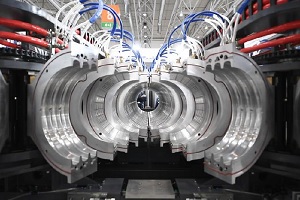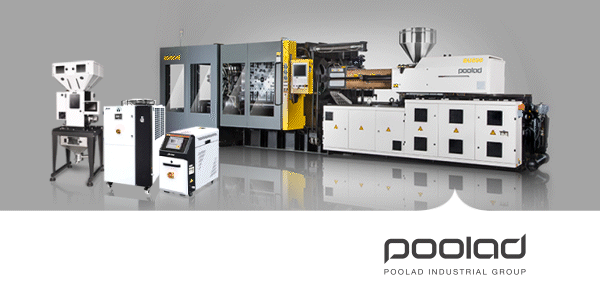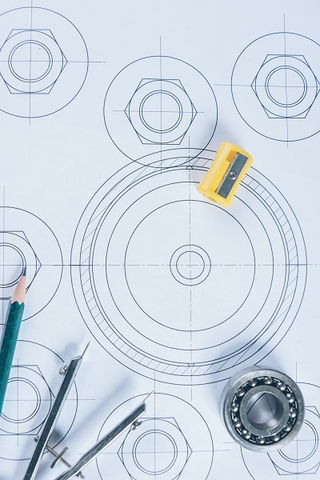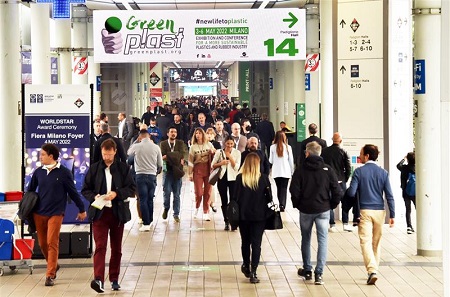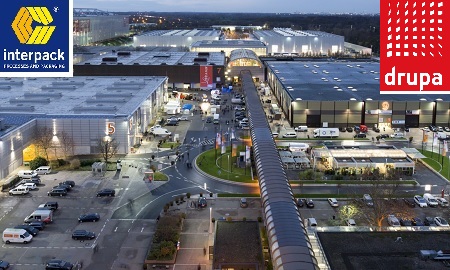The received text is copied at the following area.
***********************************

K 2025, the world-leading trade fair of the plastics and rubber industry, has set out to tackle the central challenges of our time and present concrete solutions from 8 to 15 October in Düsseldorf. This aim is also reflected by its guiding topics. One of them reads “Embracing Digitalisation”.
The plastics industry faces major economic and regulatory disruptions worldwide. Rising competitive pressure, stricter environmental regulations and higher demands made on circularity increase the pressure to innovate. On-going digitalisation offers new opportunities for producing more efficiently and sustainably here. Automated processes, data-based control systems and smart connectivity already ease adaptation to stricter requirements in many companies today. The Federal Ministry for Economic Affairs and Climate Protection’s (BMWK) Digitalisation Index 2024 provides an indication of the increasing level of digitalisation and has found that the German economy has become around 14% more digital in the last five years. This has increased especially fast in the category “Processes” which describes both the digital maturity of intra-company workflows and the connection with external partners.

Artificial Intelligence (AI) is considered a key milestone in this. According to a Bitkom study, 78% of the industrial companies polled view AI as decisive for their competitiveness while more than half are waiting to see how others get on first. At the same time, 48% lack the necessary AI skills and 91% demand fewer regulatory obstacles so as not to hamper AI innovations. These figures underline that there is broad consensus on the relevance of digitalisation but many firms are hesitant to implement it in practice.
Digital key technologies: connectivity and IoT

The digital control and connectivity of machines forms the basis for new technologies. “In plastics machinery construction automation has already been ongoing for over 40 years. Now nearly all go one step further and bank on digitalisation,” says Ulrich Reifenhäuser, (Left Photo) Chairman of the Advisory Board at K in Düsseldorf. Cyber-physical systems (CPS) and the Internet of Things or IoT make it possible to capture and evaluate production data seamlessly in real time. Sensors monitor temperature, flow rate or in-mould pressures, for example, and transmit the values to Cloud applications. An important communication standard for this is OPC UA, which makes for safe and cross-manufacturer data exchange.
Rising data volumes lead to questions of data use. According to industrial associations, the so-called “EU Data Act” has created clarity on this now. The new Data Act obliges machinery manufacturers to provide machine users with the data generated during operation in a simple and understandable, machine-readable way. At the same time, predictive maintenance moves into focus because real-time analyses can detect deviations early on and reduce unplanned downtimes.
Artificial Intelligence and automation
 AI adds new dynamism to digital processes as self-learning algorithms analyse large data volumes and optimise processes flexibly. “AI and digitalisation are game changers for the circular economy of plastics. Fully automated manufacturing processes, digital product passports and simulations make for optimised workflows and help save resources across the complete value chain,” says Dr. Alexander Kronimus, Deputy Managing Director at PlasticsEurope Deutschland, in an industry interview.
AI adds new dynamism to digital processes as self-learning algorithms analyse large data volumes and optimise processes flexibly. “AI and digitalisation are game changers for the circular economy of plastics. Fully automated manufacturing processes, digital product passports and simulations make for optimised workflows and help save resources across the complete value chain,” says Dr. Alexander Kronimus, Deputy Managing Director at PlasticsEurope Deutschland, in an industry interview.
In addition, machine learning accelerates development cycles and improves process control. Digital twins go even one step further: they depict real production lines virtually and deliver structured data on the complete machinery utilisation. Furthermore, they offer the possibility to save machine data and information in a structured and machine-readable format over the complete lifecycle. Digital twins are said to also comply with the requirements of the Digital Product Passport (DPP), which was introduced with the EU’s Ecodesign for Sustainable Products Regulation (ESPR) entering into force in July 2024. These virtual twins of real manufacturing plants accelerate development cycles and ease maintenance strategies.
Optical quality control & AI-assisted sorting
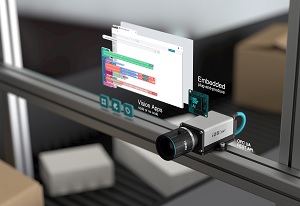
In the field of quality assurance camera systems and AI-based image processing support manufacturing processes. They detect shape deviations, surface defects or material impurities during production and ensure consistent quality levels. These technologies allow early defect detection thereby reducing rejects and ensuring a more efficient use of resources.
In the wake of stricter environmental regulations and rising customer expectations the fitness of plastics for circularity is also moving centrestage. AI-assisted sorting systems with near-IR sensors (NIR) identify different plastic types, separate high-quality recyclates from impurities and improve the recycling quality. This increases reuse rates and contributes to compliance with regulatory requirements.
What’s more, digital systems are closely linked with the DPP, which features comprehensive information about the used raw materials, production processes and recycling paths. These technologies support companies in establishing closed material cycles, reducing environmental burdens and complying with the ESPR.
Challenges and skilled labour shortage
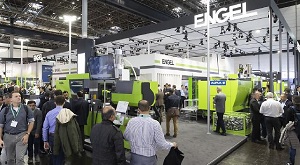
Despite numerous lighthouse projects progress is faltering in many companies, especially in SMEs. “Many small and medium-sized enterprises have not sufficiently invested in digitalisation since this is associated with substantial costs and dependent on specific skills,” reports Mauritius Schmitz of the Institute for Plastics Processing (IKV) talking to the Industry Association for Plastics Packaging (IK). Another obstacle is the shortage of skilled staff. Those wanting to introduce automation, AI and IoT technologies require specialists for data analysis and IT security. This staff and skills shortage occasionally slows down implementation even though technical solutions already exist. AR (Augmented Reality) goggles can provide relief here by displaying maintenance instructions or training content right in the staff’s field of vision. This accelerates maintenance and onboarding processes without always having external experts on site.
Summary & Outlook
 Digitalisation proves to be a catalyst for a more sustainable and efficient plastics industry. Connected production systems make for real-time optimisation thereby reducing rejects rates and buffering market fluctuations more confidently. At the same time, new business models can be developed – in the form of digital platforms and maintenance services, for example. A crucial role, however, will be played by funding. According to the Leibniz Centre for European Economic Research (ZEW) the plastics industry invests EUR 2.2 billion in innovation, a sum that only corresponds to 1.65% of the innovation expenditure of the processing industry as a whole. At the same time, the ZEW points out that 63% of companies in the sector are active in product or process innovations, which exceeds the average of 57% in the processing trade. These figures illustrate that there is a will to innovate but financial and human resources are needed to consistently implement digitalisation projects.
Digitalisation proves to be a catalyst for a more sustainable and efficient plastics industry. Connected production systems make for real-time optimisation thereby reducing rejects rates and buffering market fluctuations more confidently. At the same time, new business models can be developed – in the form of digital platforms and maintenance services, for example. A crucial role, however, will be played by funding. According to the Leibniz Centre for European Economic Research (ZEW) the plastics industry invests EUR 2.2 billion in innovation, a sum that only corresponds to 1.65% of the innovation expenditure of the processing industry as a whole. At the same time, the ZEW points out that 63% of companies in the sector are active in product or process innovations, which exceeds the average of 57% in the processing trade. These figures illustrate that there is a will to innovate but financial and human resources are needed to consistently implement digitalisation projects.
At K 2025 the enormous potential that digitalisation holds for the plastics sector will be both highlighted at the over 3,000 exhibitor stands and flagged up at the various Specials that also address the challenges – first and foremost the official K Special “Plastics Shape the Future”, organised by Plastics Europe Deutschland, or also the VDMA Forum.
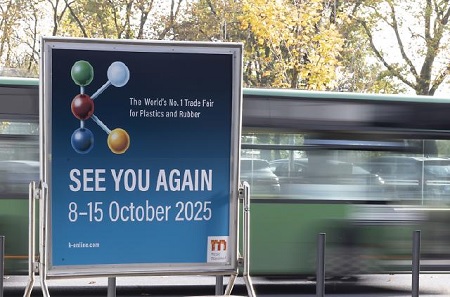
For more information go to www.k-online.com
Click here for the K online magazine:
K-Mag – The magazine of K trade fair
K Basics:
In 1952 K was held by Messe Düsseldorf for the first time and is held in a 3-year cycle. The latest K in 2022 registered 3,020 exhibitors from 59 countries on 177,516 m² net exhibition space and 177,486 trade visitors, 71% of whom came from abroad. For more information go to www.k-online.com

